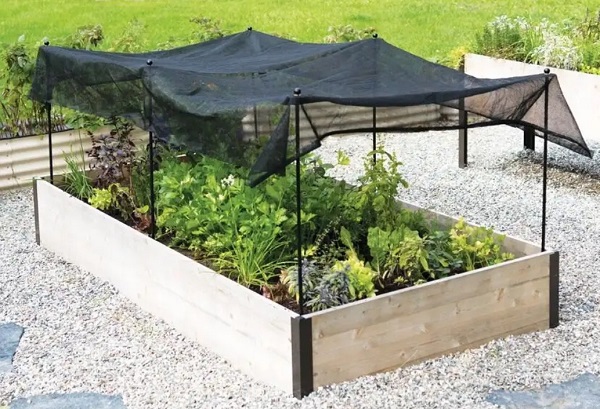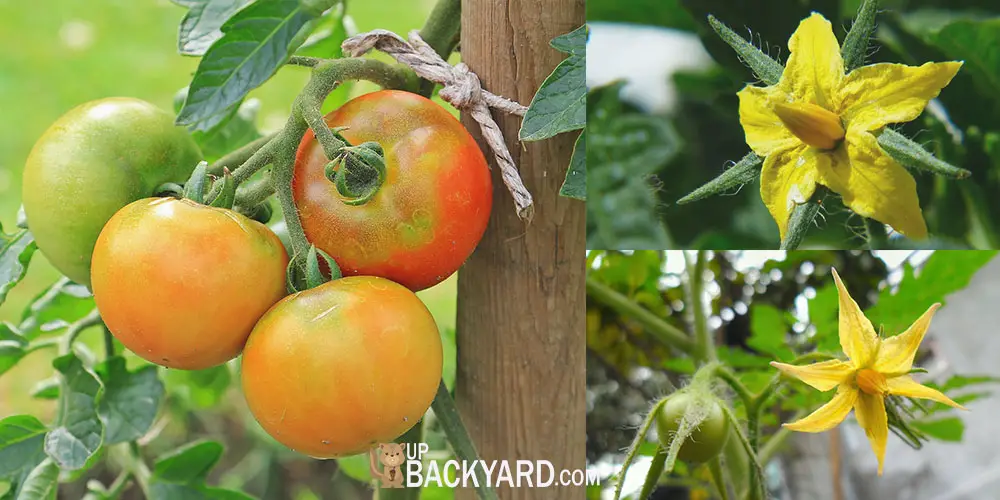When you pick up a ripe juicy tomato, you are probably not thinking that the tomato was once a beautiful yellow flower. However, it is totally true!
Tomatoes are the result of pollination of the tomato plant’s flowers during bloom. Once the pollination occurs, the flower begins to create seeds which then become centered in that red ripe tomato.
So when your tomato plant is not growing the yellow flowers needed to produce the fruit, it can be alarming.
Why Are My Tomato Plants Not Flowering?
There are a few reasons why your tomato plants are not flowers. The amount of sunlight, water, nutrition, heat, and stress that a plant is under are all things that you should check when your tomato plant is not flowering.
How To Ensure a Tomato Plant Flowers?
There are many reasons why your tomato plant is not flowering. The good news is, most of them are very simple fixes.
The first step is to figure out if your tomato plant has the right amount of necessary things like water, light, heat, and nutrition.
Making sure that the plant has a good foundation with healthy soil is also an important part of growing tomato plants.
Read on to learn how to identify a problem with your plants and how to fix it.
Water
The first thing you should check is the amount of water that your plant is getting.
Both too much and too little amounts of water can negatively impact a tomato plant. While it may seem impossible to get the “just right” level of watering, it is possible.
Generally, potted tomato plants will need to be watered daily or every other day. You will want to be sure that the pots have a good amount of drainage holes to prevent water from settling at the bottom of the pot.
Water can soak the soil and without drainage, the pooling water can cause root rot or attract bugs and increase the likelihood of mold growing in your tomato plant’s pot.
If the tomato is in the ground or planted in a raised garden bed, thoroughly soaking the soil twice a week in the beginning of the season and once weekly after they have taken to their new home, should be adequate.
Intense heat and dry weather would call for more watering. You want to avoid letting the soil get so dry it cracks.
Too much water can also be bad for a tomato plant. Another rule of green thumb is to check the soil with your finger.
Stick your finger into the ground until you feel moisture. If it is more than an inch down until you feel the moisture, it is time to water the plant.
A thirsty tomato plant will tell you it needs water. Most tomato plant varieties are extremely dramatic and will wilt when they need water. Once they are watered, they will perk right back up.
Sunlight
Next to water, sunlight may be one of the most important parts of growing tomatoes.
Tomatoes are sun-loving plants and require at least 6 hours of sun a day. Anything more than 6 hours a day is considered full sun in terms of plants.
Even 6 hours a day may not be enough for tomatoes. Tomatoes love all the sun they can get and thrive when they are grown in places that receive 8-9 hours of sun.
The light from the sun is needed to perform photosynthesis.
During photosynthesis, plants take the energy from the sun’s light and turn it into a sugar substance that the plant can then use for its own energy supply.
Plants use energy to grow taller, produce new plant cells, grow new leaves and flowers, and repair any damage.
If your tomato plants are not getting enough sunlight, they will not be able to gather enough energy to produce as many flowers.
If it is your first year growing tomatoes, it is best to grow them in pots so that you can move them if the original area does not get enough sunlight.
After you know how the sun hits different places in your garden, you can be more sure in your placement for next season.
Heat
Just like us, plants can get too hot. When the plant is in too much heat, they become droopy and sluggish.
This is also known as “heat wilt”. Heat wilt can cause your tomato plants to not flower as they are using their energy to conserve their leaves and stem.
Intense heat can stress a tomato plant out. When the plant becomes stressed, it goes into survival mode where it will not expend extra energy to produce anything new.
Sadly, this includes flowers.
If you are growing your plants in pots, moving them to a shady spot in the hottest parts of the day will help protect the tomato plants from heat wilt.
Another option if your plants are planted in the ground or you are unable to move them, is to create a shaded space for them.

Some people will use old bed linens tied to the backs of garden chairs as a makeshift shade tent for their plants.
It is important to only shade the plants during the hottest parts of the day as the plants do need a lot of sunlight.
Soil
When you go to plant your tomatoes in your garden, make sure you are using nutrient-rich soil.
Soil can be depleted of nutrients if you have grown similar crops in the area the previous year. This is why it is best to rotate crops throughout your garden.
If you are growing tomatoes in pots, use a nutrient-rich potting soil that is designed for vegetables.
These potting mixtures have nutrients and fertilizers mixed in for a one-step process for success.
You can even sprinkle some of the potting mix into the holes you plant your in-ground tomato plants in to help increase the amount of nutrients in your garden.
Even with the nutrients added to the potting soil, you may still find it beneficial to fertilize your tomato plant a few times throughout the season.
When you are fertilizing, be sure that you choose a vegetable specific fertilizer from your local garden center and read the instructions carefully.
Too much fertilizer or using the wrong kind can send your plant into shock. The wrong kind of fertilizer can literally clog the roots of the tomato plant, causing it to die slowly.
It is also best to wait at least two weeks from the time that you planted or transplanted your tomato plant and the first fertilizer.
Giving your plant time to adjust to its new surroundings and new soil is a must to prevent transplant shock.
Transplant shock can happen anytime you move a plant from one place to another. If you grew your tomato plant starts indoors, be sure to harden your tomato plants before moving them outside permanently.
Hardening is the process in which you slowly introduce your indoor plants or seedlings to the outside world.
Bringing them out for a few hours at a time gradually increasing, allows them to slowly adjust to the weather and outdoor environment.
If you do not harden your plants, you increase the risk of transplant shock.
Diseases and Pests
Something that you should consider when dealing with a stressed out tomato plant is the possibility of pests or diseases ravaging it.
Sometimes, we cannot see the pests at all because they are so small. Instead, we see the damage they cause. Sadly, by the time we catch it, it may be too late to save the plant.
Pests and diseases also tend to jump from one plant to the next rather quickly. Blight can take out an entire tomato garden in a few weeks.
If you notice your plant has signs of pests or other diseases, quickly remove the damaged and affected plant parts.
Sometimes, the amount of leaves that need to be removed will severely stunt the plant’s ability to perform photosynthesis. Without the energy from the process, the plant won’t be able to repair itself in time and will die.
If the entire plant is infected, you may have to remove the whole thing. It is better to remove a sick plant and protect the others in your garden than try to save it and have the others become diseased as well.
The best way to deal with pests and diseases is to prevent them. Use pesticides and fungicides of your choice periodically.
There are lots of options both chemical and natural that will help keep your tomato plants happy and healthy.
Final Thoughts
A tomato plant that is not flowering is a big concern for gardeners. After all, no flowers means no tomatoes.
While it can be nerve-wracking trying to diagnose why the plant isn’t flowering, there are a few things that are most likely the culprits.
Start by checking your plants water levels, soil nutrition, heat, amount of sunlight, and if the plant seems to be diseased or covered in pests.
Once you know what is most likely the cause of your tomato’s stress, you can make adjustments to help return the plant to a state of calm and optimal growth.
Soon enough, your tomato plant will be full of bright yellow flowers!
